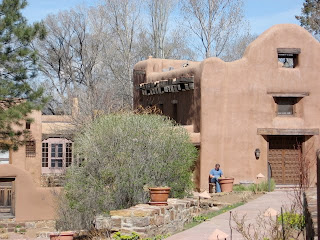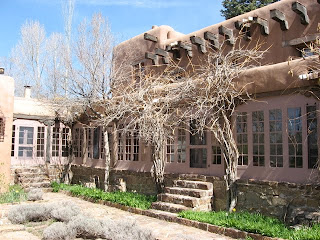 In April I was able to tour the School for Advanced Research (SAR) in Santa Fe, a truly fabulous piece of property which houses this unique institution.
In April I was able to tour the School for Advanced Research (SAR) in Santa Fe, a truly fabulous piece of property which houses this unique institution.SAR got its start in the early years of the 20th century as the School for Archaeological Research, and it was headed by anthropologist Edgar Lee Hewitt from 1907 until his death in 1946. (He simultaneously headed the Museum of New Mexico after it was established in 1909.) SAR's mission was to train students, conduct anthropological research on the American continent, and preserve and study Southwestern culture.
Meanwhile, wealthy NY socialite sisters Martha Root White and Amelia Elizabeth White discovered Santa Fe in 1923. Both had graduated from Bryn Mawr, and served as Army nursing assistants during World War I. They found Santa Fe on a cross-country trip, and bought a large property here in the city. They built a home which they called El Delirio ("the madness"), and over the years the compound grew to include a kennel, guest houses, a swimming pool, and a variety of other structures.
 El Delirio became a gathering place for artists, writers, and intellectuals, and the White sisters are said to have thrown some stunning parties in the 20s and 30s. Their home was the setting for lavish dinners, concerts, poetry readings, pool parties, plays, and masquerade balls.
El Delirio became a gathering place for artists, writers, and intellectuals, and the White sisters are said to have thrown some stunning parties in the 20s and 30s. Their home was the setting for lavish dinners, concerts, poetry readings, pool parties, plays, and masquerade balls. Five women, including poet Alice Corbin Henderson, second from left, display their costumes at the swimming pool dedication ca. 1926.
Five women, including poet Alice Corbin Henderson, second from left, display their costumes at the swimming pool dedication ca. 1926.The sisters also bred and raised Irish wolfhounds, and a cemetery for their beloved dogs can be seen on the grounds today.
Elizabeth helped to establish the Old Santa Fe Association, the Laboratory of Anthropology, the Wheelwright Museum, the Garcia Street Club, and the Santa Fe Animal Shelter--and all these organizations are still active.
 The sisters were patrons and promoters of Native American Art and they opened the first Native American art gallery in New York City. Elizabeth was a founding member of the Indian Arts Fund in 1925, an organization which focused on buying up Indian pottery and other handcrafts to preserve these artifacts for future generations. She also served on the SAR managing board for 25 years.
The sisters were patrons and promoters of Native American Art and they opened the first Native American art gallery in New York City. Elizabeth was a founding member of the Indian Arts Fund in 1925, an organization which focused on buying up Indian pottery and other handcrafts to preserve these artifacts for future generations. She also served on the SAR managing board for 25 years.Martha died in 1937, but Elizabeth lived to be 96 years old. And when she died, in 1972, she left El Delirio and its remaining acres to the School for Advanced Research, giving that institution its first permanent home. That same year, the Indian Arts Fund also disbanded and deeded its collections to SAR.
 The Resident Scholars' communal dining room--all set for delicious food and stimulating conversation.
The Resident Scholars' communal dining room--all set for delicious food and stimulating conversation.Today, SAR runs an advanced seminar series and a resident scholar program. The latter has provided over 160 pre- and postdoctoral scholars with nine-month residencies in which to read, reflect, and write up research results. A key part of the program is the unique intellectual interaction which takes place among scholars from different but related disciplines. Native artists have the opportunity to do residencies on site while they work on their art. SAR also houses the IAF collections and a state-of-the-art archaeological repository, and the SAR Press produces books on archaeology, anthropology, and Southwestern art and culture.
The grounds are beautiful, and a tour provides a look at SAR as it currently exists, and historical views of both SAR and the life of the White sisters.
 The cemetery for the White sisters' Irish wolfhounds--each dog is identified by name.
The cemetery for the White sisters' Irish wolfhounds--each dog is identified by name.Illustration Credits and References
Photo of the White sisters' party at El Delirio courtesy of the SAR website (sarweb.org). All other photographs by the author.

1 comment:
Thank you for your 2010 article on the White sisters. I find them fascinating.
Post a Comment